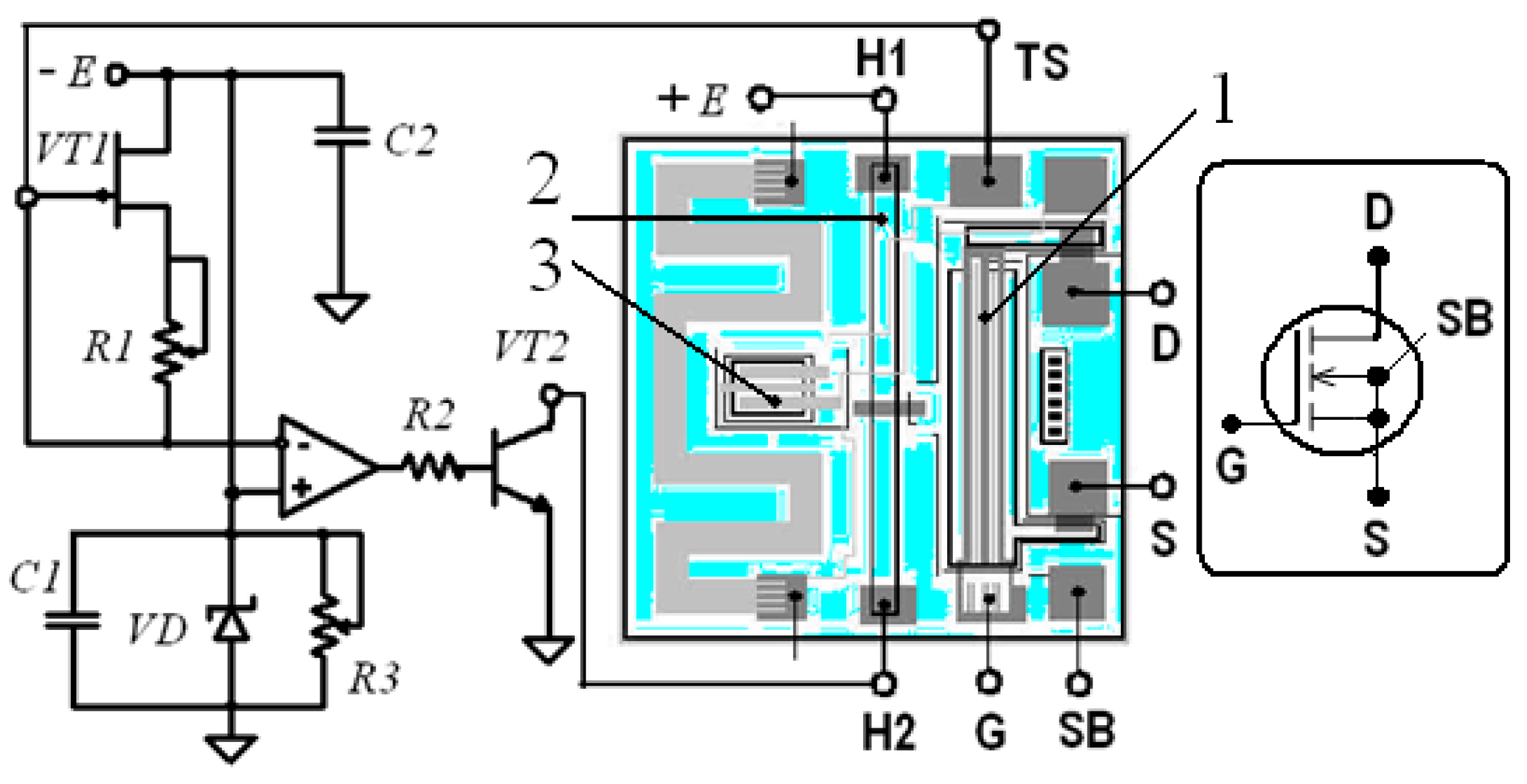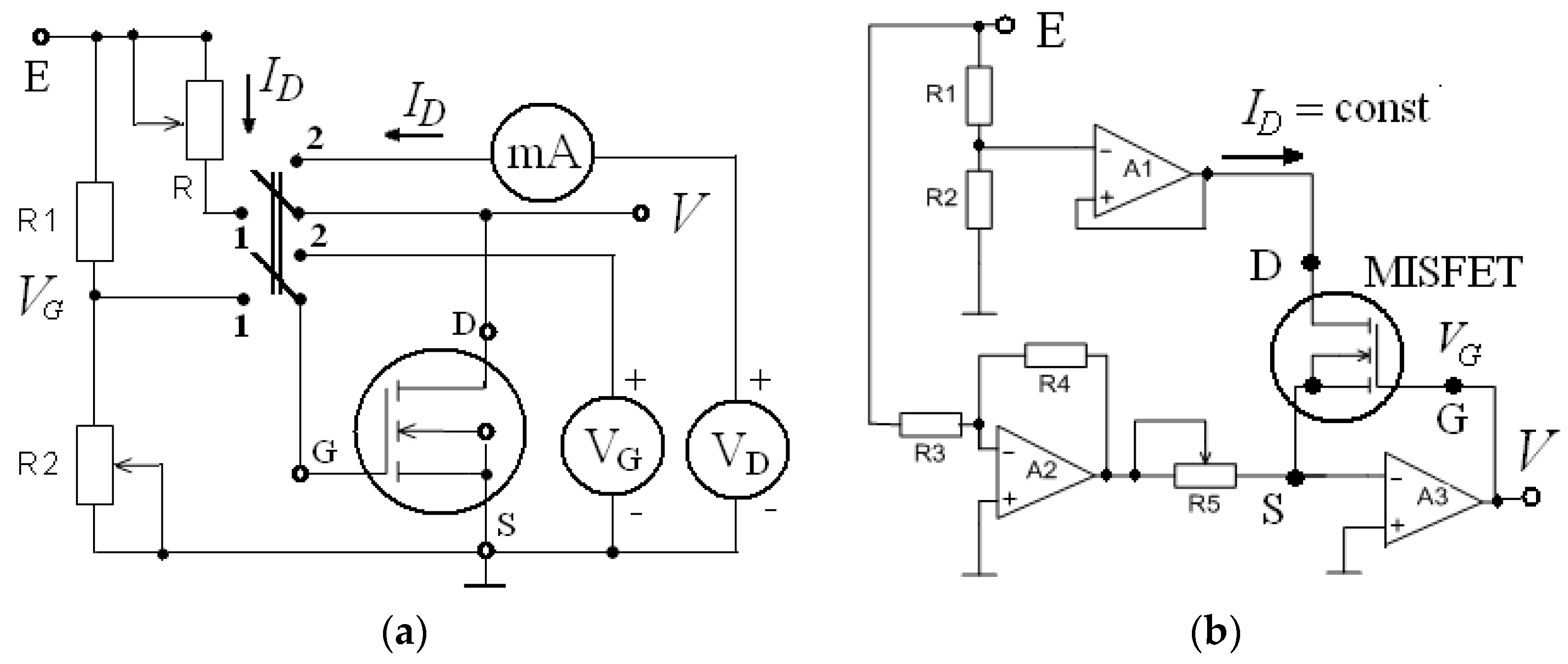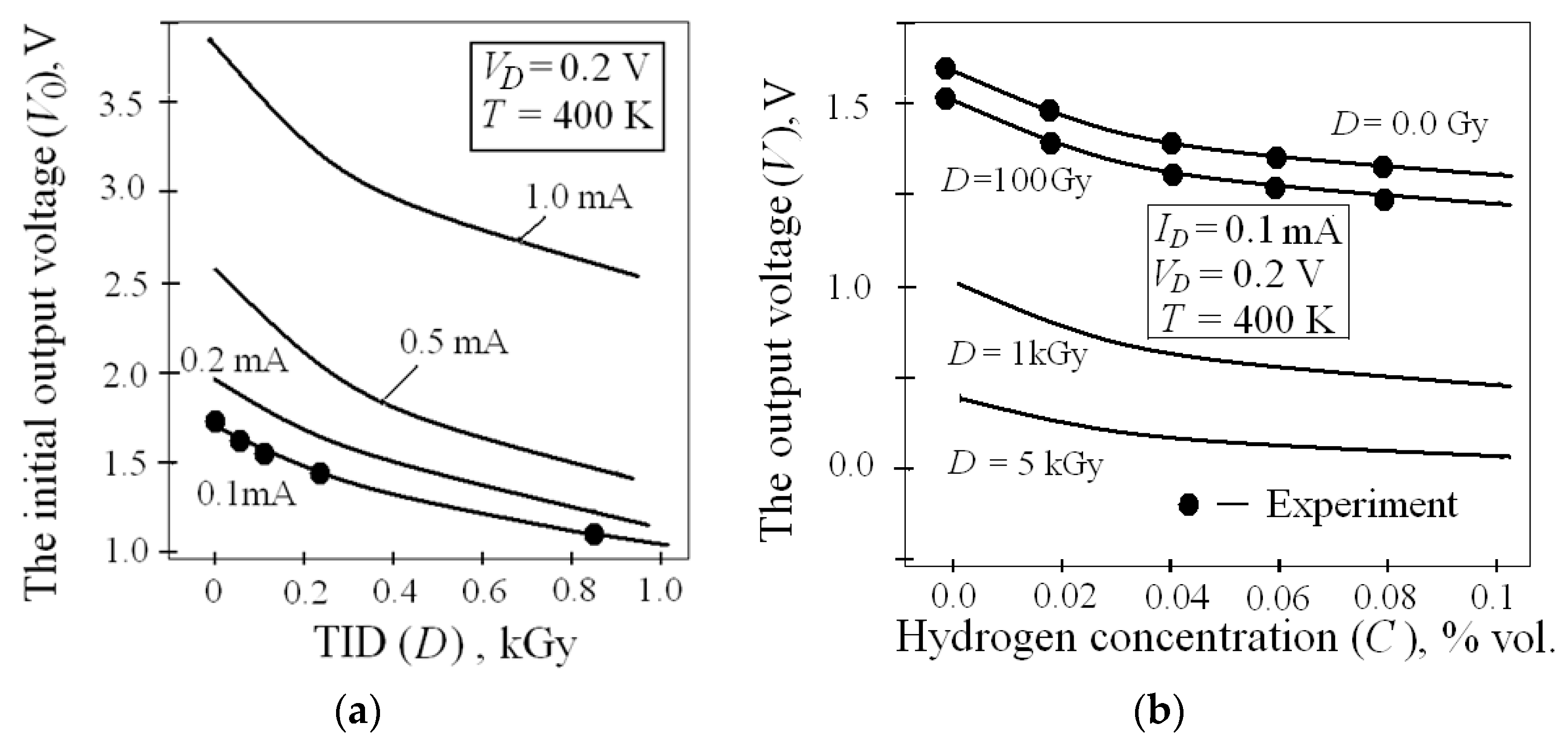Influence of Electrical Modes on Radiation Sensitivity of Hydrogen Sensors Based on Pd-Ta2O5-SiO2-Si Structures †
Abstract
:1. Introduction
2. Materials and Methods
3. Results Are Presented in Figure 3and Figure 4
4. Discussion
ΔVss = ΔVssM [1−exp(−k2D)]; ΔVC (C; D) =ΔVCM [1−exp(−kC)]·{1 − exp[−k3(D3 − D)]}
U(C; D) = VG − VT0 = VG − VT00 + ΔVC + ΔVte − ΔVss; β = bR.
5. Conclusions
Conflicts of Interest
References
- Lundström, I.; Armgarth, M.; Spetz, A.; Winquist, F. Gas sensors based on catalytic metal-gate field-effect devices. Sens. Actuators 1986, 3–4, 399–421. [Google Scholar] [CrossRef]
- Lin, K.-W.; Cheng, C.-C.; Cheng, S.-Y.; Yu, K.H.; Wang, C.-K.; Chuang, H.-M.; Chen, J.Y.; Wu, C.-Z.; Liu, W.-C. A novel Pd/oxide/GaAs metal–insulator–semiconductor field-effect transistor (MISFET) hydrogen sensor. Semicond. Sci. Technol. 2001, 16, 997–1001. [Google Scholar] [CrossRef]
- Lundström, I.; Sundgren, H.; Winquist, F.; Eriksson, M.; Krants-Rülcker, C.; Lloyd-Spets, A. Twenty-five years of field effect gas sensor research in Linköping. Sens. Actuators B 2007, 121, 247–262. [Google Scholar] [CrossRef]
- Kalinina, L.; Litvinov, A.; Nikolaev, I.; Samotaev, N. MIS-Field Effect Sensors for low concentration of H2S for enviromental monitoring. Procedia Eng. 2010, 5, 1216–1219. [Google Scholar] [CrossRef]
- Andersson, M.; Pearce, R.; Lloyd-Spetz, A. New generation SiC based field effect transistor gas sensors. Sens. Actuators B 2013, 179, 95–106. [Google Scholar] [CrossRef]
- Podlepetsky, B.I.; Nikiforova, M.Y.; Kovalenko, A.V. Chip temperature influence on characteristics of MISFET hydrogen sensors. Procedia Eng. 2016, 168, 251–254. [Google Scholar] [CrossRef]
- Podlepetsky, B.I. Effect of irradiation on hydrogen sensors based on MISFET. Sens. Actuators B 2017, 238, 1207–1213. [Google Scholar] [CrossRef]
- Zaininger, K.H. Electron bombardment of MOS capacitors. Appl. Phys. Lett. 1966, 8, 140–144. [Google Scholar] [CrossRef]
- Lenahan, P.M.; Dressendorfer, P.V. Hole traps and trivalent silicon centers in metal/oxide/silicon devices. J. Appl. Phys. 1984, 55, 3495–3499. [Google Scholar] [CrossRef]
- Ionizing Radiation Effects in MOS Devices and Circuits; Ma, T. , Dressendorfer, P., Eds.; Willey & Sons: New York, NY, USA, 1989. [Google Scholar]
- Esqueda, I.S.; Barnaby, H.J.; King, M.P. Compact Modeling of Total Ionizing Dose and Aging Effects in MOS Technologies. IEEE Trans. Nucl. Sci. 2015, 62, 1501–1515. [Google Scholar] [CrossRef]
- Podlepetsky, B.I. Integrated Hydrogen Sensors Based on MIS Transistor Sensitive Elements: Modeling of Characteristics. Autom. Remote Control 2015, 76, 535–547. [Google Scholar] [CrossRef]
- Podlepetsky, B.I. Total Ionizing Dose Effects in Hydrogen Sensors based on MISFET. IEEE Trans. Nucl. Sci. 2016, 63, 2095–2105. [Google Scholar] [CrossRef]




| Parameters | VT00, V | b0, mA/V2 | ΔVteM, V | ΔVssM, V | k (1/%) | k1, Gy–1 | k2, Gy–1 | k3, Gy–1 | D3, kGy(Si) |
|---|---|---|---|---|---|---|---|---|---|
| Values | 1.35 | 2.0 | 1.65 | 1.5 | 14 | 6 × 10–4 | 3 × 10–5 | 2 × 10–4 | 15 |
| TID, Gy(Si) | ΔVTCM, V | ∆Vte, V | ∆Vss, V | VT0, V | V0, V | SCM, %/V | b, mA/V2 | ||
| VG = 1.5 V | VG =2 V | VG = 1.5 V | VG = 2 V | ||||||
| 50 | 0.47 | 0.06 | 0.002 | 1.32 | 4.96 | 4.50 | 2.76 | 9.34 | 2.0 |
| 100 | 0.47 | 0.10 | 0.005 | 1.26 | 4.94 | 4.44 | 3.29 | 9.87 | 2.0 |
| 250 | 0.47 | 0.23 | 0.012 | 1.13 | 4.86 | 4.24 | 4.85 | 12.1 | 1.9 |
| 850 | 0.45 | 0.66 | 0.04 | 0.73 | 4.28 | 3.39 | 8.9 | 14.5 | 1.7 |
Publisher’s Note: MDPI stays neutral with regard to jurisdictional claims in published maps and institutional affiliations. |
© 2017 by the authors. Licensee MDPI, Basel, Switzerland. This article is an open access article distributed under the terms and conditions of the Creative Commons Attribution (CC BY) license (https://creativecommons.org/licenses/by/4.0/).
Share and Cite
Podlepetsky, B.; Kovalenko, A.; Nikiforova, M. Influence of Electrical Modes on Radiation Sensitivity of Hydrogen Sensors Based on Pd-Ta2O5-SiO2-Si Structures. Proceedings 2017, 1, 446. https://doi.org/10.3390/proceedings1040446
Podlepetsky B, Kovalenko A, Nikiforova M. Influence of Electrical Modes on Radiation Sensitivity of Hydrogen Sensors Based on Pd-Ta2O5-SiO2-Si Structures. Proceedings. 2017; 1(4):446. https://doi.org/10.3390/proceedings1040446
Chicago/Turabian StylePodlepetsky, Boris, Andrew Kovalenko, and Marina Nikiforova. 2017. "Influence of Electrical Modes on Radiation Sensitivity of Hydrogen Sensors Based on Pd-Ta2O5-SiO2-Si Structures" Proceedings 1, no. 4: 446. https://doi.org/10.3390/proceedings1040446




